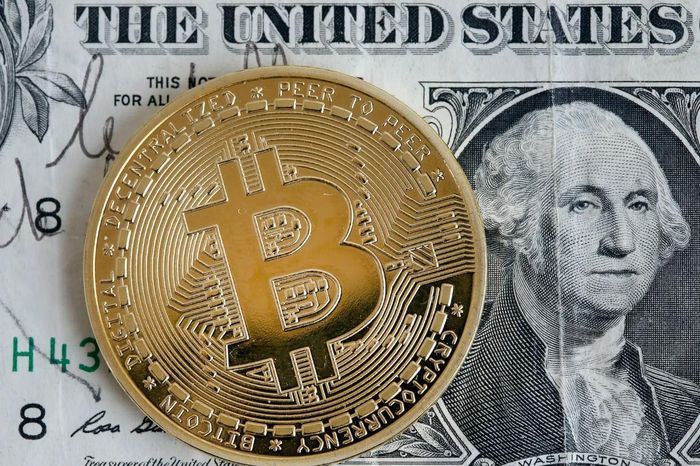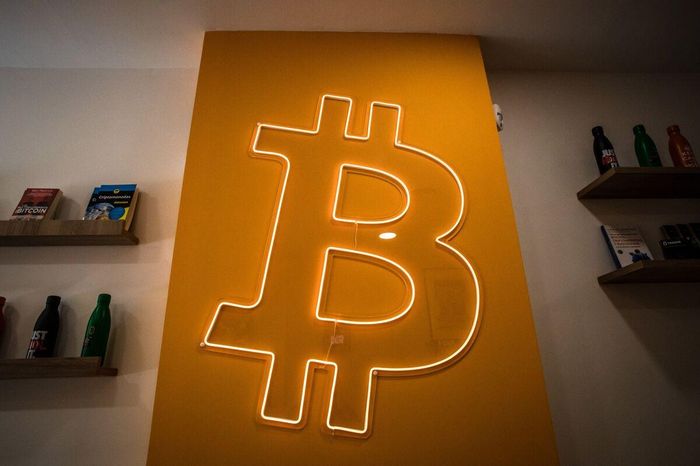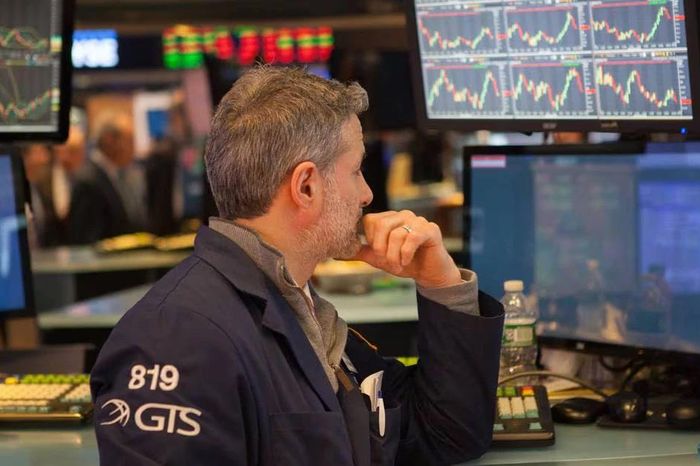Cash flow from ETFs returns, Bitcoin bounces above the $65,000 mark after hitting a 2-month bottom

Cash flow from IBIT fund ends positive streak
The cryptocurrency market entered the "Sell in May and Go Away" phase quite early when at the end of April, Bitcoin's streak of 7 consecutive months of growth ended, replaced by an adjustment of about 16% - the worst monthly decline since June 2022 to date.
With a relatively new market like cryptocurrency, there are many factors that can impact and affect the up/down trend.
Regarding general developments, it can be seen that the price of the currency representing the Bitcoin market began to decline around mid-March. This time coincided with investors' concerns about the Reserve The US Federal Reserve (Fed) may apply more drastic policy changes in the face of unpredictable inflation in recent months. There have even been many experts who have made assumptions that the Fed may not cut interest rates this year. This sent the DXY index to its highest level since November, and this is typically a bearish signal for risk-on assets such as the stock market and electricity.
Not only that, the complicated inflation context in the US also affects capital flows in spot Bitcoin ETFs. Initial signs of trouble appeared on April 25 when BlackRock's Bitcoin ETF (IBIT) ended a streak of 71 consecutive days of inflows. During this period, IBIT did not see any new cash inflows but total cash outflows amounted to $120 million. Grayscale's GBTC fund also recorded significant outflows, exceeding $130 million. In contrast, Fidelity's FBTC fund attracted $5.6 million and Ark's ARKB fund added $4.2 million in inflows.
By May 2, almost all Bitcoin ETFs recorded capital outflows for the first time with a total value of up to 563.7 million USD and recorded the largest loss since being licensed. trading began in January. During the brief decline, funds have lost about $6 billion over the past four weeks, representing a 20% decline in assets under management. According to expert observers, at the present time, Bitcoin ETFs are the main driving force driving the market. Therefore, in the short term, small fluctuations from these ETFs will cause the market to be directly affected. In addition, the fact that small investors with unstable psychology are caught up in the selling vortex will also cause the phenomenon of short selling (long squeeze), causing the price of the asset to drop even more sharply.
Behind rain, it has sunshine
However, after hitting the lowest bottom in 2 months (about 56,000 USD), the cryptocurrency market has begun to flourish again. After 7 days of recording a series of continuous cash outflows, on May 3, Bitcoin ETF funds recorded positive cash flows. This is even the first day the GBTC fund has positive cash flow (63 million USD) after 78 days of being in the red. Previously, GBTC recorded capital outflows of up to $17.4 billion, with an average of $224 million per day since converting to a spot Bitcoin ETF. As of the time of writing, Bitcoin price has recovered to above the $65,000 mark.
In a report recently published by Coinbase, analysts said that the recent correction not only happened in the cryptocurrency market but also happened in traditional financial markets (end In April, Dow Jones lost 5% of its score, S&P 500 lost 4.2%, while Nasdaq fell 4.4%). In addition, another positive point pointed out by analyst David Han is that Bitcoin's recent correction only had a maximum decrease of 23% from the peak and this is a relatively low correction in the history of the coin. this cryptocurrency.
On the other hand, the trend of the cryptocurrency market following traditional financial markets is predicted by experts to continue because Bitcoin has been legalized and considered a macro asset in Vietnam. some countries such as the US, Canada, Europe, Australia. Although the cash flow from Bitcoin ETFs in countries outside the US is not high, this can be seen as a signal of participation in the market. Cryptocurrency market of asset management funds in the world.
According to BlackRock, investment funds and large companies are also starting to show signs of participating in the market through Bitcoin ETFs. In the first quarter of 2024, the second largest bank in Europe BNP Paribas made a move to purchase IBIT shares. Financial institutions such as sovereign wealth funds, pension funds and endowments could start investing in Bitcoin ETFs within a few days, said Robert Mitchnick, head of digital assets at BlackRock. next month after learning about the market.
You should read it
- Spot Bitcoin ETFs hit record highs in trading volume and inflows
- Hong Kong officially approved a series of Bitcoin spot ETFs
- Reasons why Bitcoin surpassed its historical peak
- The world only has 20% Bitcoin to 'dig'
- The state bank announced it banned the use of bitcoin in Vietnam
- Bitcoin finds its heyday
- Crossing virtual walls, Bitcoin exploded in real life
- Bitcoin broke $40,000, the market capitalization of the entire cryptocurrency market lost $2 trillion
May be interested
- 7 prominent Bitcoin events outside the US in 2024
 bitcoin surged to an all-time high last week with the halving event a month away. here are 7 facts that show bitcoin is still shaking the world outside the us in 2024.
bitcoin surged to an all-time high last week with the halving event a month away. here are 7 facts that show bitcoin is still shaking the world outside the us in 2024. - Bitcoin broke $40,000, the market capitalization of the entire cryptocurrency market lost $2 trillion
 with the crash underway, the bitcoin price has officially dropped below the $40,000 mark per coin. bitcoin's crash also led to a drop in a host of other cryptocurrencies.
with the crash underway, the bitcoin price has officially dropped below the $40,000 mark per coin. bitcoin's crash also led to a drop in a host of other cryptocurrencies. - Bitcoin, Ethereum ETF in Hong Kong could usher in more progressive policies in China
 this week, spot bitcoin and ethereum etfs were conditionally approved in hong kong. along with this news, digital asset platform osl also announced it will be the 'subcustody partner' for both china asset management (chinaamc) and harvest global investment etf.
this week, spot bitcoin and ethereum etfs were conditionally approved in hong kong. along with this news, digital asset platform osl also announced it will be the 'subcustody partner' for both china asset management (chinaamc) and harvest global investment etf. - Next up is the Ethereum spot ETF?
 new bitcoin spot exchange-traded funds (etfs) have ushered in an era that will see trillions of dollars poured into tokenization. next up is the ethereum spot etf?
new bitcoin spot exchange-traded funds (etfs) have ushered in an era that will see trillions of dollars poured into tokenization. next up is the ethereum spot etf? - Bitcoin conquers the $62,000 mark again
 bitcoin price recovered on monday as investors awaited april us inflation data, which could play a key role in influencing the federal reserve's decision on whether to interest rates should be reduced by 2024…
bitcoin price recovered on monday as investors awaited april us inflation data, which could play a key role in influencing the federal reserve's decision on whether to interest rates should be reduced by 2024… - Bitcoin price today June 6: Continuing the upward momentum to reach the 71,150 USD mark
 bitcoin price traded at 71,167.14 usd/btc, up 0.48% in the past 24 hours.
bitcoin price traded at 71,167.14 usd/btc, up 0.48% in the past 24 hours. - Bitcoin price today April 3: Continuing the downward trend, trading around the 65,900 USD mark
 bitcoin price traded at 65,915.36 usd/btc, down 1.32% in the past 24 hours.
bitcoin price traded at 65,915.36 usd/btc, down 1.32% in the past 24 hours. - Bitcoin price today April 4: Continuing the downward trend, trading around the 65,650 USD mark
 bitcoin price traded at 65,646.95 usd/btc, down 0.68% in the past 24 hours.
bitcoin price traded at 65,646.95 usd/btc, down 0.68% in the past 24 hours. - In a week, the number of people downloading Coinbase was twice as much as Instagram
 last month's bitcoin prices surged, attracting more and more investors to participate in the virtual money market.
last month's bitcoin prices surged, attracting more and more investors to participate in the virtual money market. - Bitcoin price today April 9: Strong increase in trading around the 71,300 USD mark
 bitcoin price traded at 71,292.19 usd/btc, up 2.74% in the past 24 hours.
bitcoin price traded at 71,292.19 usd/btc, up 2.74% in the past 24 hours.










 Bitcoin 'dinosaur' awakens after 10 years of hibernation
Bitcoin 'dinosaur' awakens after 10 years of hibernation Where does the rapid development of Blockchain technology come from?
Where does the rapid development of Blockchain technology come from? Bitcoin's decline is a warning to global markets
Bitcoin's decline is a warning to global markets Many traders bet Bitcoin will reach $100,000 in September
Many traders bet Bitcoin will reach $100,000 in September Bitcoin price today April 27: Dropped to 63,000 USD
Bitcoin price today April 27: Dropped to 63,000 USD How did the cryptocurrency scam boss narrowly escape an 11,196-year prison sentence?
How did the cryptocurrency scam boss narrowly escape an 11,196-year prison sentence?